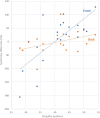Interoception and Empathy Impact Perspective Taking
- PMID: 33536971
- PMCID: PMC7848222
- DOI: 10.3389/fpsyg.2020.599429
Interoception and Empathy Impact Perspective Taking
Abstract
Adopting the perspective of another person is an important aspect of social cognition and has been shown to depend on multisensory signals from one's own body. Recent work suggests that interoceptive signals not only contribute to own-body perception and self-consciousness, but also to empathy. Here we investigated if social cognition - in particular adopting the perspective of another person - can be altered by a systematic manipulation of interoceptive cues and further, if this effect depends on empathic ability. The own-body transformation task (OBT) - wherein participants are instructed to imagine taking the perspective and position of a virtual body presented on a computer screen - offers an effective way to measure reaction time differences linked to the mental effort of taking an other's perspective. Here, we adapted the OBT with the flashing of a silhouette surrounding the virtual body, either synchronously or asynchronously with the timing of participants' heartbeats. We evaluated the impact of this cardio-visual synchrony on reaction times and accuracy rates in the OBT. Empathy was assessed with the empathy quotient (EQ) questionnaire. Based on previous work using the cardio-visual paradigm, we predicted that synchronous (vs. asynchronous) cardio-visual stimulation would increase self-identification with the virtual body and facilitate participants' ability to adopt the virtual body's perspective, thereby enhancing performance on the task, particularly in participants with higher empathy scores. We report that participants with high empathy showed significantly better performance during the OBT task during synchronous versus asynchronous cardio-visual stimulation. Moreover, we found a significant positive correlation between empathic ability and the synchrony effect (the difference in reaction times between the asynchronous and synchronous conditions). We conclude that synchronous cardio-visual stimulation between the participant's body and a virtual body during an OBT task makes it easier to adopt the virtual body's perspective, presumably based on multisensory integration processes. However, this effect depended on empathic ability, suggesting that empathy, interoception and social perspective taking are inherently linked.
Keywords: bodily self-consciousness; empathy; illusion; interoception; perspective taking.
Copyright © 2021 Heydrich, Walker, Blättler, Herbelin, Blanke and Aspell.
Conflict of interest statement
The authors declare that the research was conducted in the absence of any commercial or financial relationships that could be construed as a potential conflict of interest.
Figures



References
LinkOut - more resources
Full Text Sources
Other Literature Sources

